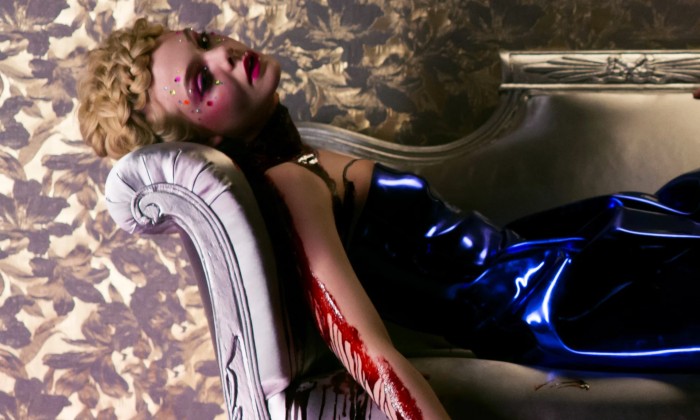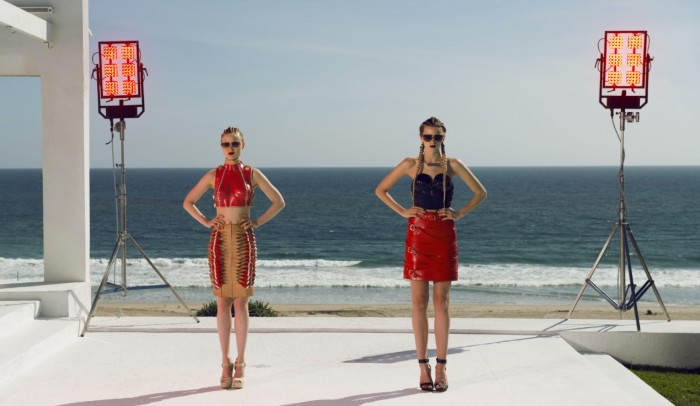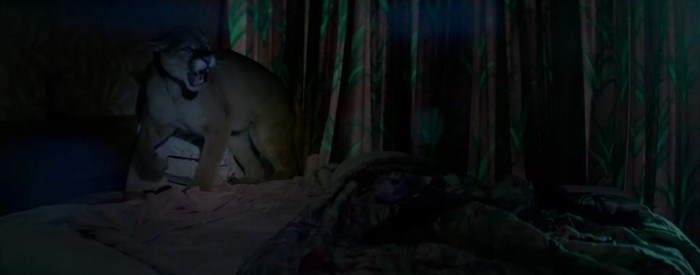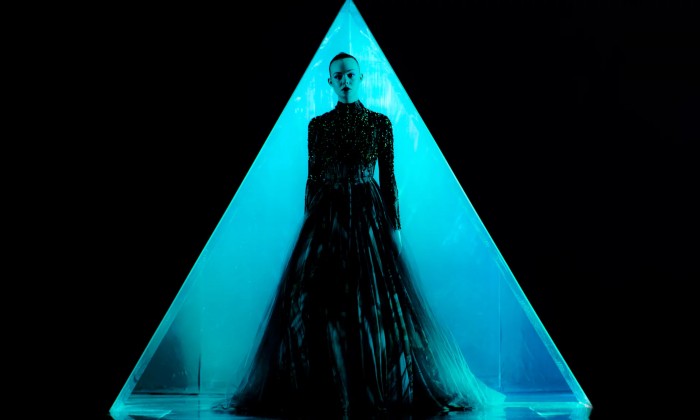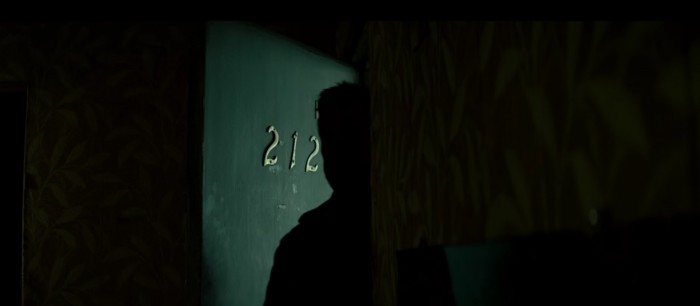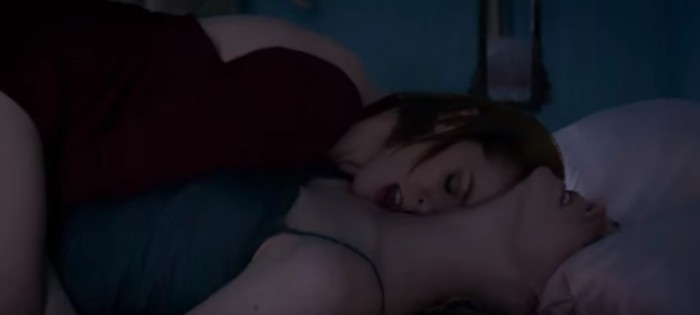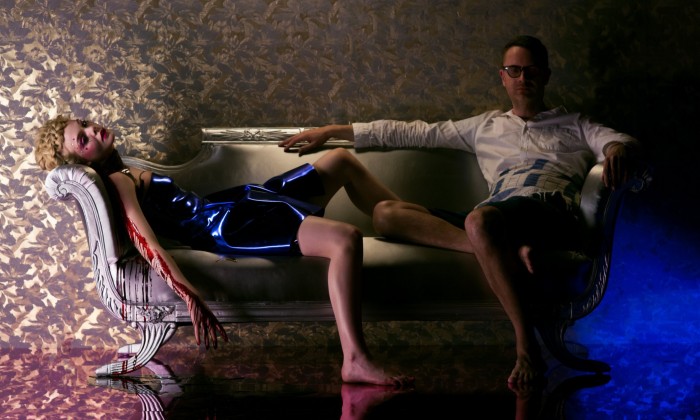The Neon Demon Ending & Movie Explained: Your Questions Answered
Nicolas Winding Refn's The Neon Demon is a beautifully shot yet polarizing film. It's either shallow, pretentious, sensationalistic and self-indulgent or a bold haunting hypnotic work of suspense. I'm still not sure if I liked it or not, but It has certainly remained with me since my viewing of the film over the weekend. My reaction is typical — the movie has gotten a very mixed reaction from critics and film geeks.
My viewing has prompted a deep dive into interviews and analysis of the film, and I thought I'd share some of the insights into The Neon Demon ending, the symbology and metaphors both obvious and more hidden. I'll also attempt to answer some of your The Neon Demon questions.
Warning: Spoilers for the film follow.
The Beginning Of The End
The film opens on Jesse (Elle Fanning) laying down in a blue dress covered in blood laying totally lifeless. Or as Refn has described it, "Elle Fanning lying on the couch, covered in blood. Death and beauty. Snow White just died." Moments later we realize that Jesse isn't dead, the scene was created for a fashion photoshoot. Its this imagery that inspired the rest of the film. Refn told EW the following:
"Every time I was at a creative crossroad, I would go back to the opening image and say, 'Why is it that this came to me so specifically? There's something very similar, in a strange way, between beauty and death because the obsession of it, the longevity of it, and the youth of it can only mean that it will die, so what is one willing to do?
This opening scene is also about setting the tone for the entire film. Is this reality or is it something else? Refn wants the viewer to keep asking themselves this question while watching his film. The final act of The Neon Demon answers the question, and the answer might not be what everyone was expecting or wanting. That in mind, Refn has said that he felt the whole movie was about that last scene:
"That's where it kind of reveals itself, so everything goes back to the beginning, but it's not revealed until the last few minutes."
What Do The Characters Represent?
Early in the film, Jesse meets three women: Jena Malone who plays make-up artist Ruby, and her two model friends Gigi (Bella Heathcote) and Sarah (Abbey Lee). Each of the women represent a different aspect of beauty. Refn explains as much in an interview with Slant:
You have to look at the three women: You have Abbey Lee, who's external beauty, Bella Heathcoate is a woman who tries to recreate beauty artificially, and then you have Jena Malone—who's all about inner beauty, virginity, and innocence. Beauty is one of the most complex subjects we have within this world, because you have to look within yourself.
What about the other characters in this story? Each of them are symbolic pieces in this story as Refn explained to HollywoodChicago:
Jesse begins as the classic 'A Star is Born' character, coming to the big city...it's almost a sub genre. ... The photographer becomes a portal between aesthetics and obsession. The boyfriend is normalcy, but he is hypocritical. And then there is the Keanu Reeves character, who comes off as a sexual predator. All those characters are part of the Jesse DNA. They each point in different directions from her.
Its interesting that the boyfriend character is to represent normalcy, and is essentially the good guy trying to warn her of the path she is on, but he's also an of age dude who is okay dating a 16-year-old. It may seem less weird if the movie didn't point this out to us. Later in the film Reeves' motel manager character warns him about girls like Jesse, and suggests he should instead look towards a younger Lolita-type girl who is staying in one of the rooms next door. I'm not sure what this is supposed to represent.
There aren't too many male roles in the film. Aside from Keanu and the boyfriend Dean played by Karl Glusman, there's also the sleazy fashion photographer played by Desmond Harrington. Refn has explained that the reason that the men have such small appearances is because "Men have no place in the movie." The filmmaker told Fastcocreate:
The male characters were like the girlfriends of other films. They're plot devices. They're there to tell a certain part of the story mechanically. In the end, the film is all about women," Refn says, pointing out that the guys disappear about halfway through the movie. "They were no longer needed in the film, so I took them out."
Although I'm not sure that "girlfriends of other films" isn't bad screenwriting.
The Mountain Lion In Jesse's Room
It seems odd that a mountain lion would break into a second floor motel room, but the city of Pasadena does warn that the wild predators frequent the city. The imagery in The Neon Demon is often times not so subtle but in your face. The image of the mountain lion tearing up the motel room is surreal, and I think this is one way that Refn is setting up audiences for what is to come.
After the reveal of the mountain lion in Jesse's room, Keanu Reeves's character Hank doesn't jump to protect Jesse. Instead he blames her for leaving the patio door open. Is the mountain lion a metaphor for how Jesse had left the door open which had allowed monsters to come into her life?
The Meaning Of The Colors
Refn worked with cinematographer Natasha Braier to incorporate a strong use of color in the film, specifically red and blue. Those two colors in particular were chosen because the filmmaker is colorblind. Braier explained the meaning behind the colors in an article she wrote for The Guardian:
I set a base of colours to represent specific emotions. Red meant danger and was in every scene with Jena Malone's Ruby. We planned this well in advance. At times plans would change though; Nic would say: "It's dark, but why don't you go darker?" That's a sensibility that Nic and I share; the last thing we want to do is to play it safe. ... The blue had a lot to do with the Greek myth Narcissus, and to reflect Elle Fanning's climactic narcissistic moment, so we did an abstract representation of going to the pond and looking at her reflection in the triangle. That's when she's going to transform into red and go from the Alice In Wonderland girl to the empowered beauty queen. It's very subtle; it's done with just light and mirrors. If we'd had another $5 million it could have been underwater but we had to do it with no money, so it was a minimalist realisation of the Narcissus story.
As for the triangle, that was inspired by the work of artist James Turrell.
"He's a sculptor of light, but an architect too. His works become, for me, sacred spaces. That reference gave the triangle in The Neon Demon a subliminal touch of the spiritual as well."
In Jesse's first runway show, we are presented with this surreal presentation which includes Jesse kissing reflections of herself, finally embracing her narcissism. Refn has defended his film's use of narcissism and vanity. Here is a quote from the Village Voice:
Neon Demon is about beauty, which is written off by many people as being superficial. But generally people have a very complicated relationship to beauty, because it's really about themselves — your own vanity, how you see yourself, narcissism. Elle [Fanning] and I wanted to make a horror film for a teenage audience about a theme that for them is much more advanced than what we're used to. You and I were brought up to think of narcissism as a taboo, something negative. My kids' generation, Elle's generation, sees it as a virtue. That is so fascinating, and complex. The meaning is so clear, but how crazy is it that this is the way that it's moved?
This explanation seems more like a justification of why twenty-something or older middle age critics didn't like the movie.
The Keanu Reeves Deep Throat Knife-mare
Later in the film, Keanu Reeves's character Hank is seen breaking into Jesse's motel room and sticking a big knife down her throat. It's definitely a dream or a nightmare, but what does it mean? Refn told Vulture that the knife deep-throat nightmare is "where the movie touches upon Jesse's fear of penetration, and that's what she imagines."
"That's her nightmare about the predatorial aspect of the film, because beauty is not about just what you look like, it's also what other people want from the inside — youth, perfection, purity, and virginity."
A sequence follows that shows a man trying to break into her motel room. While Jesse plants herself against the door to ensure that doesn't happen, the man breaks into the hotel room next door (possibly the Lolita that Hank references earlier), although that room number is supposed to be two rooms adjacent. Jesse hears the carnage that happens through the wall, which is what gets her to call Jena Malone's character Ruby in an effort to escape.
Is it possible that this too is a nightmare? Jesse has become a bit more narcissistic through the course of this journey and maybe that has begun to turn to paranoia. Also why didn't Jesse call the police instead of Ruby?
The Necrophilia Scene
After being denied by Jesse, Jena Malone's character Ruby gets intimate with a dead woman at the mortuary. This scene was originally planned to be much different. The screenplay initially had Ruby kissing the dead body, played by model Cody Renee Cameron. Refn explained to the Telegraph how it evolved:
"Jena kissed the body and I just said instinctively, 'Can you spit in her mouth?'?" So Jena spat in her mouth. And then I go, 'OK, can you touch her...' Jenna kissed the body and I just said instinctively, 'Can you spit in her mouth?' And after we cut, I was like, 'We found the character.' It became this very fragile, melancholy scene," Refn goes on, while peeling a hard-boiled egg. (His breakfast comprises three of them, yolks removed and discarded, plus two double espressos and two glasses of water, one still, one sparkling.) "It was grotesque, but there was also something very sad about it. And after we cut, I was like, 'We found the character.'?"
While the film was shot chronologically allowing Refn to change and alter the path as he wanted, this scene was shot early in the shoot because they wouldn't be able to return to the location. It was in the shooting of this sequence that Refn says that he finally discovered the story's villain.
The End Of The Story
Coming out of this movie, I wanted to believe that there was something more interesting hidden within the ending, but as I come to end my deep dive, it seems like the ending of the film is mostly literal. At the end of the story Jesse is literally devoured by Ruby, Gigi and Sarah, a not so subtile visualization of how an innocent sweet girl is destroyed by a town like Los Angeles and the fashion industry. Refn has explained that when she's devoured, "three things happen":
We mentioned earlier that the last scene of the movie was influenced by the first. Refn has also explained that Jesse's eye was the first and last thing we see.
"In Neon Demon, I knew that Jesse had to be devoured at the end. I wanted the eye to be what brings it all full circle."
Definitely not the first film to use the first shot/last shot motif.
Why Was The Film Dedicated To Liv?
The film ends with a dedication to Liv. I wasn't initially going to include this bit in this Neon Demon roundup as its not related to the story itself, but I thought others might have the same question: Who is Liv? And why is this film dedicated to her?
Liv is a danish actress, documentary filmmaker who also happens to be Refn's wife. The reason the filmmaker dedicated the movie to her was that she inspired the film.
She was the idea behind the film. Two years ago, I woke up depressed one morning. I wasn't born beautiful, but my wife was. And I thought, "I wonder what it'd be like to have been born beautiful." And of course, there's a sixteen-year-old girl in every man. This is a way to do my version of her. It made sense going from Drive, which was the height of masculinity, and my own fetishization of a hero, and even Only God Forgives, where Ryan's character is my own male obsession deconstructing itself and emasculating itself, trying to crawl back into the womb of the mother. And now, I am reborn as a sixteen-year old girl. In the end, beauty was what I was making a film about, and the only person I knew around me who was beautiful was my wife.
So there you have it. I hope that this deep dive into The Neon Demon has either clarified some things or answered a few of your burning questions.

